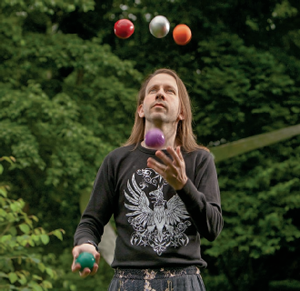![]() For one math professor, juggling is a numbers game
For one math professor, juggling is a numbers game
For one math professor, juggling is a numbers game
Mathematics professor Allen Knutson has always been good at juggling numbers, but he's also pretty handy at tossing other things around. Knutson, who specializes in algebraic combinatorics, is a record-setting juggler and an authority on siteswap, the system used to annotate juggling patterns.
Developed in 1985 in the U.S. and England, siteswap uses numbers to describe juggling throws. For example, a "1" is a quick, straight toss from one hand to the other and a "3" is a chin-high toss that stays aloft for three beats. Odd numbers indicate a toss that is made from hand to hand while even numbers are thrown and caught by the same hand; the higher the number, the more time the object spends in the air.

The system allows jugglers to record new routines or quickly learn existing ones. And because it's bound by the physical realities of throwing and catching, the patterns unfold in predictable ways. If a juggler increases the height of one throw, for instance, then siteswap holds that a later throw must be decreased in height by an equal amount.
Knutson took up the hobby in 1987 as a freshman at Caltech, a bastion of juggling aficionados. As a junior, he and a friend broke the world passing record by juggling twelve balls, a record they held for five years. Knutson, who can still juggle seven balls by himself, now gets invitations to lecture all over the world—at both juggling conventions and academic meetings of mathematicians. "I spoke at an event in Rome," he says, "where the speakers were mostly Field medalists and Nobel prize winners . . . and then me."
Recently, while doing research related to graph theory, Knutson was thrilled to realize that siteswap offered the perfect way to describe the phenomenon he was studying. "To see that the right way to think about what I was working on was with juggling patterns," he says, "was one of my most delightful discoveries as a mathematician."
— Erica Southerland '10
{youtube}38rf9FLhl-8{/youtube}
Watch Knutson in action (60:00)


